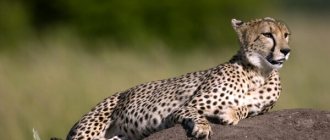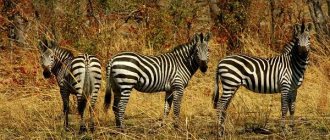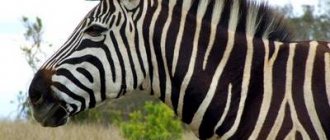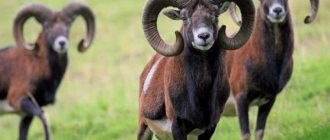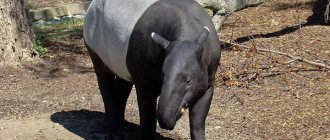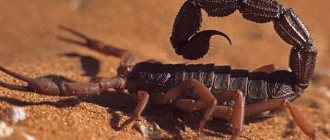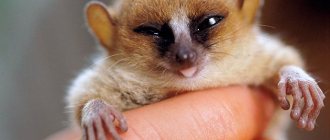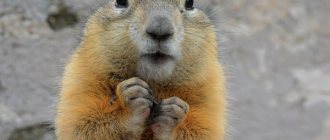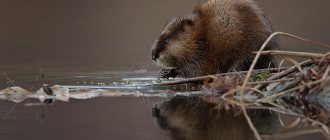Description and features
The appearance of the small predator resembles several animals familiar in appearance - marten, raccoon, mongoose and cat. , the African civet is assigned to the family of civet mammals, which is why in its historical homeland the animal is often called a civet cat.
In terms of dimensions, the animal can be comparable to a small dog - height 25-30 cm, body length 60-90 cm, tail approximately 35 cm. The size and weight of the animal from 7 to 20 kg vary depending on the species. Among related representatives, African inhabitants are the largest.
The civet's head is wide in shape, its body is elongated and thick, and its tail is strong. The muzzle is elongated, like a raccoon. Small ears, slightly pointed. Eyes with oblique slits and round pupils. The animal has a strong mouth with strong teeth. The civet is able to bite through everything, even very hard objects.
Strong paws with five toes. The claws do not retract, as in all felines, and the places where soft pads are usually located are covered with fluffy hair. Medium-length limbs help the animal in deft jumps, rapid running, and agility.
A mane, approximately 10 cm high, stretches across the long body, from the beginning of the neck to the wide tail at the base, which gradually tapers towards the end. The short-haired fur of an animal is not distinguished by its quality and beauty. The density of wool varies from place to place.
The thickest cover is on the tail, sparse, uneven, and rough along the body. When an animal is frightened, in moments of danger the fur stands on end, significantly increasing the size of the predator. The civet rears up to appear even larger, sometimes hunches its back like a real cat, and stands sideways to demonstrate its terrifying size.
The color of the animal is heterogeneous. In front is a muzzle, a neck, as if wearing a black mask, similar to the outfit of a raccoon. The general color of the coat is from yellowish-red to gray-brown. Spotted-striped pattern, darker than the main background. In the far part of the body, the coat color resembles the skin of a hyena. The paws are always black. There are 4-5 black rings on the tail, and the very tip is dark brown.
The civet in the photo is quite a pretty animal, with an extraordinary appearance. The animals are distributed in limited areas, sub-Saharan Africa. Civets live in China, the Himalayas, Madagascar, and some subtropical and tropical countries in Asia. It is impossible to see a civet in our country in natural conditions; even in zoos it is very rare.
This amazing animal is listed in the Red Book and is protected by international animal protection organizations. In captivity, civets are quite tamed if they are caught at a young age. The owners keep the animals in cages and feed the predators meat.
Since ancient times, perfumers have shown particular interest in animals, attracted by the odorous secretions of animals. The cost of a civet's anal glands costs a lot of money. In ancient times, the substance civet was worth its weight in gold. The musk secreted by was used to make medicines.
The civet harvesting craft, which was put on stream, became associated with the hunt for civets and the domestication of animals. In captivity, young animals gradually become attached to people. Adults are very difficult to tame. The approach of people causes excitement and anxiety in mature animals. They wheeze, raise their fur, arch their backs, and secrete musk with a pungent aroma.
In Ethiopia, there are entire civet farms; elite French perfumes are made from the products supplied. In the modern perfume industry, the civet trade is becoming less popular due to the production of synthetic musk. Civet hunting is becoming less common.
Kinds
There are six species of civet, of which the African is the largest. The Leakey species is extinct.
Malabar civet. The color of small animals (length up to 80 cm, weight 8 kg) is predominantly gray-brown, with large black spots on the sides of the body and on the hips. A black stripe stretches along the ridge. Tail and throat of a civet with gray and black stripes.
An extremely rare species, individual populations of which do not exceed 50 individuals. The total number of surviving animals is approximately 250. It lives in the thickets of small cashew plantations in India, which are under threat of large-scale deforestation. Saving animals is seen solely through captive breeding.
Large spotted civet. The muzzle of predators of this species is very similar to that of a dog. The animal's size is slightly smaller than the African civet variety. The name refers to the characteristic color. Large spots merge into stripes, creating a vertical or horizontal pattern.
Black and white stripes decorate the throat, neck, and tail of the animal. Retractable claws distinguish the inhabitants of evergreen, coastal forests of Cambodia, China, India, and Vietnam. Although civets are excellent climbers, they feed exclusively on the ground. Animals are classified as species with vulnerable numbers.
Tangalunga. A small-sized civet, the distinctive features of which are a large number of stripes on the tail and frequent spotting on the back. A black stripe along the midline of the ridge extends to the very tip of the tail.
From the bottom of the body, white fur with black spots rises to the throat. It climbs trees deftly, but prefers a terrestrial lifestyle. It lives in many protected areas of the Malay Peninsula, the Philippines, and other adjacent islands.
Great civet (Asian). A large predator of its kind, it lives in the forests of Asian countries and is found at elevations up to 1500 m. Body length is up to 95 cm, weight is approximately 9 kg. For comparison, the small civet does not exceed 55 cm in length.
Leads a nocturnal, solitary lifestyle, common in Indochina, Nepal, and Vietnam. A beautiful animal with a bushy tail. The massive body is black and brown in color. Alternating black and white stripes adorn the animal's long tail and neck. The animal prefers foothill landscapes and hilly slopes.
Lifestyle and habitat
The animal leads a secretive lifestyle, prefers to live among tall grasses with areas of thickets in order to always hide from prying eyes. The palm civet lives in the middle layers of tropical forests.
The animals know how to hide, so it is very difficult to see a civet in the wild. A prerequisite for existence on the home site is a pond located nearby. Civets do not tolerate drought. Animals love cool, wet weather and swim well.
Predators are solitary in life, uniting only during reproduction. Nests are built in other people's burrows, most often taking over the home of an aardvark and an anteater. Sometimes it settles in old hollows and caves.
The animals do not dig their own shelters, since their paws are poorly suited for digging. Secluded places are needed only by females with cubs, and free individuals do not claim a permanent place. During the day, animals rest among tall grasses and tangled tree roots, and in the evening they go out hunting.
The most active times are between sunset and midnight. The hunting area is marked with odorous musk and feces. Animals mark their territory several times a day. The information in the smell of the secretion of the anal glands is individual and stores the characteristics of each individual.
Although the animals do not encroach on neighboring territories, they still communicate with their relatives, emitting vocal signals in the form of growls, coughs, and laughter. The characteristics of the voices convey information about protection, readiness to make contact, and threats.
Civets spend most of their time on the ground, although they can deftly climb trees and hills. Natural dexterity allows bold predators to even get into farms to feast on chicken and small livestock, which causes discontent among local peasants.
In the homeland of the civet, residents actively use civet, the animal's musk, to spray their homes. The smell, which the Malays value, is unbearable for Europeans who are not accustomed to such features.
Etymology[edit]
Common name Civettictis
is
a mixture
of the French word
civette
and the Greek word
ictis
, meaning "weasel."
The name of the specific civette
and the common name "marten" are derived from the French
civette
or the Arabic
zabad
or
sinnawr al-zabad
("civet"). [13]
Local and indigenous names[edit]
- In Tigrinya: ዝባድ ( zibad
) [14] - In Akane: cankane
Nutrition
The diet of the predatory animal includes a variety of animal and plant foods. Amazing omnivorousness is manifested in the fact that the animal even eats poisonous plants, carrion - much that other inhabitants of the living world refuse.
During the evening hunt, civets catch small birds and rodents. They sit in ambush for a long time, waiting for the approach of prey. Then they attack, deftly grabbing victims with their teeth. The predator bites the spine of the prey with its teeth and gnaws the neck. The civet does not use its paws for cutting carcasses. The animal holds the victim in its mouth with its teeth, breaking its bones in the process of shaking its head.
Civets willingly eat insects and their larvae, destroy nests, feast on eggs and chicks, look out for reptiles, pick up decomposed carcasses infested with bacteria, carrying out sanitary cleaning in natural conditions. Civet cats are known to attack domestic chickens and other yard animals.
The civet also includes fruits in its diet; it eats tubers of various plants, soft parts of corn stalks, and poisonous fruits of tropical forests. Even strychnine, which is part of the chilibuha plant, the vomiting nut, does not harm civet cats.
Hunting
In nature, the African civet hunts mainly at night. These animals look out for prey for a long time and follow it, hiding in the tall grass. Finding the best moment, civets attack the victim, grabbing it with their teeth. They tightly squeeze their mouths, preventing the prey from escaping, and begin to shake their heads violently. Due to the shaking, the caught victim's spine breaks, which leads to his death.
Reproduction and lifespan
Female civets become sexually mature at one year of age. Mating time varies in different habitats. An important condition for the breeding period is an abundance of food and a warm season. In West Africa, civets breed year-round, in South Africa - from early August to January, in Kenya, Tanzania - from March to the end of October. Fetal development lasts 2-3 months. During the year, a female civet brings 2-3 litters, each with up to 4-5 cubs.
For the birth of offspring, the civet sets up a den. A place for the nest is not built, but is chosen among the abandoned burrows of large animals. Sometimes the female settles in dense thickets, among tangled roots and grass.
The cubs are born fully developed. The bodies are covered with soft fur, and the puppies can even crawl. The fur, in comparison with adult animals, is darker, shorter, and the pattern is weakly expressed. By the fifth day, babies stand on their feet, show play behavior at 10-12 days of age, and by the eighteenth day they come out of hiding.
While nursing the offspring, the female feeds the puppies with milk for up to six weeks. At two months of age, they begin to obtain food on their own and lose dependence on mother's milk.
Life expectancy in natural conditions is 10-12 years. Under human conditions, the lifespan increases to 15-20. It is noteworthy that African civets in captivity often kill newborn puppies and eat their offspring.
Links[edit]
- Jump up
↑ Chisholm, Hugh, ed.
(1911). "Civet". Encyclopædia Britannica
.
6
(11th ed.). Cambridge University Press. paragraph 402. - Lau, Susanna KP; and others. (2005). "Coronavirus-like severe acute respiratory syndrome virus in Chinese horseshoe bats". Proceedings of the National Academy of Sciences
.
102
(39):14040–14145. DOI: 10.1073/pnas.0506735102. PMC 1236580. PMID 16169905. - "Summary of probable SARS cases with disease onset from November 1, 2002 to July 31, 2003." . World Health Organization (WHO). Retrieved October 31, 2008.
- Gaubert P., Cordeir-Estrela, P. (2006). Phylogenetic systematics and rate of evolution of Viverrinae (Mammalia, Carnivora, Viverridae) within feliformes: implications for faunal exchange between Asia and Africa [ permanent dead link
]. Molecular Phylogenetics and Evolution 41: 266–278. - The Straight Dope: Does the civet come from tortured cats? Does Kopi Luwak coffee come from pre-eaten beans?
- Mathai, J. (2010). "Jose the Civet: Borneo's Mysterious Carnivore." Nature Watch 18/4: 2-8.
- ^ ab Brewed Coffee: Civet Coffee, November 30, 2006, retrieved May 25, 2009
- Onishi, Norimitsa (April 17, 2010). "From Manure to Flavorless Coffee Drink". New York Times
. - From the civet ute of Great Coffee, retrieved July 22, 2010
- "The disturbing secret of the world's most expensive coffee". National Geographic
. April 29, 2016 - Jennings, A.P.; Seymour, A.S.; and Dunston, N. (2006): “Long-range behavior, spatial organization and activity of the Malayan civet (Viverra tangalunga) on Buton Island, Sulawesi.” Journal of Zoology
, 268: 63–71. DOI: 10.1111/j.1469-7998.2005.00023.x - "Assessing the conservation of Civettictis civetta". ResearchGate
. Retrieved December 1, 2022. - ↑
"The Great Musang",
Wild Singapore
, 2009.
Civet and coffee
Few coffee lovers, even coffee connoisseurs, know about the technology for preparing the most expensive variety in the world, “Kopi Luwak”. The unusual method causes an ambiguous attitude towards the product, but this does not in any way affect the established traditions, high demand and cost of the elite variety, which is much higher than that of natural bean coffee. What is the connection between the civet animal and coffee ?
The secret is that the civet prefers to eat the ripest coffee fruits. In the digestive system of a wild predator, the grains are not poisoned; the enzymes of the gastric juice remove only the bitterness inherent in the drink. High-quality fruits, after internal processing in the digestive tract of the animal, are excreted unchanged in excrement.
Farmers collect a valuable product, wash it well, dry it, and sell it to resellers. The civet fruit business is popular in Vietnam, Indonesia, the Philippines, South India, the islands of Java, Sulawesi and other Indonesian archipelagoes. Some states have limits on the collection of civet feces.
The emergence of an elite drink was the result of the pathological stinginess of the leadership of the East Indies, which forbade the natives to try the fruits of the coffee trees that they grew. An enterprising peasant was the first to find a way to taste the unknown drink, after which it gained unprecedented popularity, although many still consider the method of preparation barbaric.
Attempts have been made to breed animals on an industrial scale in order to produce coffee with incredible taste. Particularly popular is the Malayan civet - a small animal, up to 54 cm long, weighing up to 4 kg. The second name of the animal is musang, and the coffee obtained after processing by the animal is musang coffee.
But true experts notice a significant difference between the drink obtained from industrially produced beans and coffee from fruits collected by peasants. The reason for the decline in quality lies in the fact that animals at coffee factories do not select the beans, but eat those that are given to them. The native method is an order of magnitude superior to the industrial method in terms of results.
Civet coffee is as exotic as the animals themselves. Tamed individuals are quite peaceful, trainable, and attractive even without the selfish intention of getting musk or golden coffee beans from the animal.
Relationships with people[edit]
The Malayan civet is found in many habitats, including forests, secondary habitats, cultivated land, and on the outskirts of villages, and is highly adaptable to human disturbance, including "selective logging" (partial removal of forests). [eleven]
African civets ( Civettictis civetta)
are listed as Least Concern, but in some regions of Africa the population is declining due to hunting, direct and indirect poisoning, and an increase in large agricultural fences restricting population flow. They are also considered relatively abundant options in the bushmeat trade. [12]
Urban environment [edit]
Palm civets often venture into cities and suburbs, and people often complain about civet feces and the noise of animals climbing on roofs. Several studies have been undertaken to study and mitigate such conflict between humans and animals. [13]

